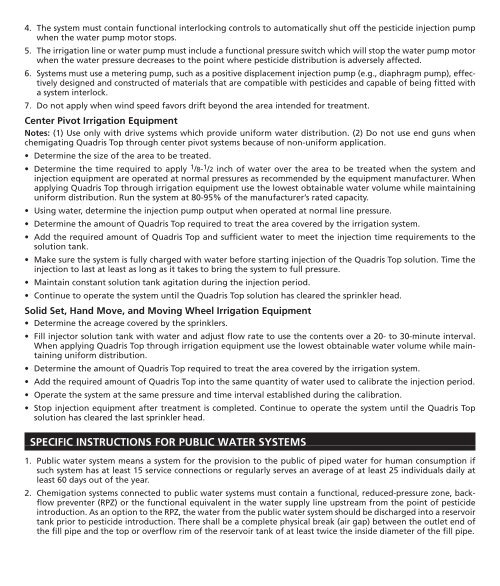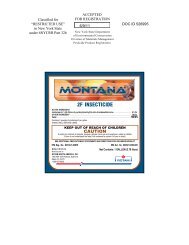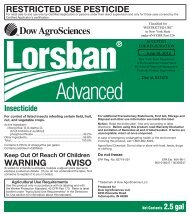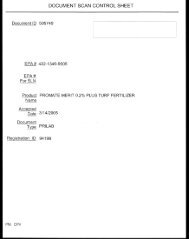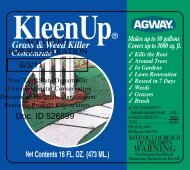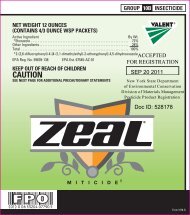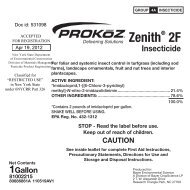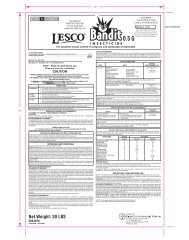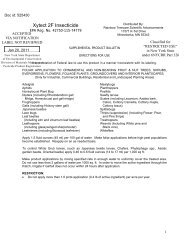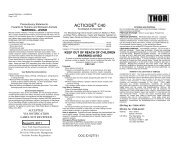4014310-PE5149-Quadris Top-2.5gal.bklt.indd
4014310-PE5149-Quadris Top-2.5gal.bklt.indd
4014310-PE5149-Quadris Top-2.5gal.bklt.indd
You also want an ePaper? Increase the reach of your titles
YUMPU automatically turns print PDFs into web optimized ePapers that Google loves.
4. The system must contain functional interlocking controls to automatically shut off the pesticide injection pump<br />
when the water pump motor stops.<br />
5. The irrigation line or water pump must include a functional pressure switch which will stop the water pump motor<br />
when the water pressure decreases to the point where pesticide distribution is adversely affected.<br />
6. Systems must use a metering pump, such as a positive displacement injection pump (e.g., diaphragm pump), effectively<br />
designed and constructed of materials that are compatible with pesticides and capable of being fitted with<br />
a system interlock.<br />
7. Do not apply when wind speed favors drift beyond the area intended for treatment.<br />
Center Pivot Irrigation Equipment<br />
Notes: (1) Use only with drive systems which provide uniform water distribution. (2) Do not use end guns when<br />
chemigating <strong>Quadris</strong> <strong>Top</strong> through center pivot systems because of non-uniform application.<br />
• Determine the size of the area to be treated.<br />
• Determine the time required to apply 1 /8- 1 /2 inch of water over the area to be treated when the system and<br />
injection equipment are operated at normal pressures as recommended by the equipment manufacturer. When<br />
applying <strong>Quadris</strong> <strong>Top</strong> through irrigation equipment use the lowest obtainable water volume while maintaining<br />
uniform distribution. Run the system at 80-95% of the manufacturer’s rated capacity.<br />
• Using water, determine the injection pump output when operated at normal line pressure.<br />
• Determine the amount of <strong>Quadris</strong> <strong>Top</strong> required to treat the area covered by the irrigation system.<br />
• Add the required amount of <strong>Quadris</strong> <strong>Top</strong> and sufficient water to meet the injection time requirements to the<br />
solution tank.<br />
• Make sure the system is fully charged with water before starting injection of the <strong>Quadris</strong> <strong>Top</strong> solution. Time the<br />
injection to last at least as long as it takes to bring the system to full pressure.<br />
• Maintain constant solution tank agitation during the injection period.<br />
• Continue to operate the system until the <strong>Quadris</strong> <strong>Top</strong> solution has cleared the sprinkler head.<br />
Solid Set, Hand Move, and Moving Wheel Irrigation Equipment<br />
• Determine the acreage covered by the sprinklers.<br />
• Fill injector solution tank with water and adjust flow rate to use the contents over a 20- to 30-minute interval.<br />
When applying <strong>Quadris</strong> <strong>Top</strong> through irrigation equipment use the lowest obtainable water volume while maintaining<br />
uniform distribution.<br />
• Determine the amount of <strong>Quadris</strong> <strong>Top</strong> required to treat the area covered by the irrigation system.<br />
• Add the required amount of <strong>Quadris</strong> <strong>Top</strong> into the same quantity of water used to calibrate the injection period.<br />
• Operate the system at the same pressure and time interval established during the calibration.<br />
• Stop injection equipment after treatment is completed. Continue to operate the system until the <strong>Quadris</strong> <strong>Top</strong><br />
solution has cleared the last sprinkler head.<br />
SPECIFIC INSTRUCTIONS FOR PUBLIC WATER SYSTEMS<br />
1. Public water system means a system for the provision to the public of piped water for human consumption if<br />
such system has at least 15 service connections or regularly serves an average of at least 25 individuals daily at<br />
least 60 days out of the year.<br />
2. Chemigation systems connected to public water systems must contain a functional, reduced-pressure zone, backflow<br />
preventer (RPZ) or the functional equivalent in the water supply line upstream from the point of pesticide<br />
introduction. As an option to the RPZ, the water from the public water system should be discharged into a reservoir<br />
tank prior to pesticide introduction. There shall be a complete physical break (air gap) between the outlet end of<br />
the fill pipe and the top or overflow rim of the reservoir tank of at least twice the inside diameter of the fill pipe.


